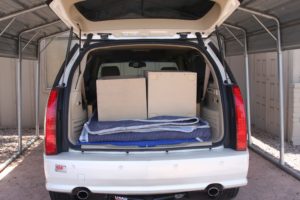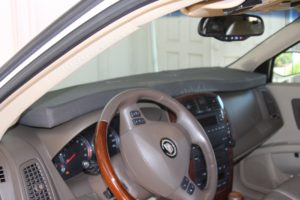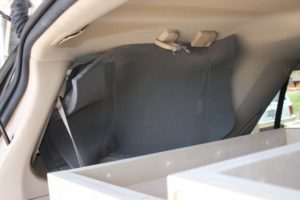Car Audio – Bass
Having good bass sound in our cars is always been an issue for the serious person. Trying to achieve good sound with any frequency range in a car is a real challenge. It is difficult because a car is really a glass fish bowl with furniture in it (car seats). It is a glass fish bowl with steel reinforced sides all riding on rubber or some type pf rubber composite wheels. We have road noise, engine noise, and noise from relatives during the holidays. We must not have any bass “noise”.
Fish Bowl
Bass or low frequency energy is hard to manage in our fish bowl. We must view our car as a fish bowl. In that fish bowl is a microphone or our ears. The fish bowl is filled with water which represents the excess pressure created by our bass drivers. We need to add the correct frequency absorbing sponges to the interior of the car in order to absorb or drink this excess water from the fish bowl. Once accomplished, the fish bowl becomes listenable to humans and fish alike.
Mass Is Horsepower
To absorb bass in a car you must use mass. This is a very high pressure area due to its size and composition. It is a steel fish bowl with laminated safety glass, similar to the lamination process used in studio installed glass windows. It can hold bass energy for brief periods of time. The acoustic goal is to have powerful absorbers with a high rate of attack at low frequencies. Only diaphragmatic absorption, with Q busting cabinet fill, can achieve these rates and levels in small amounts of space.
Diaphragmatic Absorbers
Diaphragmatic absorbers with activated carbon inserts can achieve the high rates and low levels of absorption required in our fish bowl. A good start is 220 pounds of absorbers placed in the rear of the our fish bowl. This sounds like a good start point for our listening test for tight and clean bass with the proper attack and decay rate. These two units, each at 110 pounds, will provide all the bass management the small, stock, Bose rear drivers will require.
Middle And High Frequencies
Middle and high frequency issues are made worse by the glass windows. Reflections from our side door windows and rear side door windows must be managed. If we were not going to drive our car and require visibility for driving, we can put acoustic foam on the side door windows for the driver and passenger side.
Glass Sound
Sound takes on the characteristics of the materials that it strikes. If it strikes glass, we get glass sound. Glass sound is harsh, glaring, and bright. If it strikes fabric, we get a fabric type sound. Fabric sound is smoother without the glare and brightness of glass. Wood is a popular building material because sound that strikes wood takes on a warm and richer tonal quality. Wood sound is the exact opposite of glass or fabric sound.
Use The Dash
Since we can not do that, we go for another surface that causes massive amounts of reflected energy, the front windshield. A dash mounted piece of acoustic foam will assist us with this. A 2″ thick piece of acoustic foam fits easily on the dash. It is not a substitute for side window treatment, but since we have to see out of them to drive, we need to treat the next greatest surface offender.
All Windows Not Used
All windows not used to see out of should be treated with acoustical foam. If you have a SUV, there are windows in the rear section of your SUV that even the rear seat passengers do not use. Please cover them with acoustical foam.
Car Ceiling
The ceiling or roof area is an area for absorption and also for diffusion technology. Absorption amounts and thickness will be determined by available space and whether or not the ceiling area is a moon roof that needs to be retracted. Absorption on our interior roof surface can go along way to absorbing sound energy around the driver and passenger seat area. Reflections off the front windshield and side glass doors need as much help with controlling reflections as we can get.
No Room
The down side to the amount of low frequency absorption one needs to really control low frequency energy in our glass bowl is size and weight of the absorption technology. Reducing the pressure levels in our bowl, is no easy task especially since most car audio systems have multiple drivers both in the front of the vehicle and the rear area.
Large Absorbers Required
It is large because we are trying to lower the pressure levels inside our small sized glass bowl. We could lower the windows for a start. A lowered window is a perfect sound absorber with 100% efficiency. Once sound leaves the car through the window, it is gone forever. We all need sound absorbers that work this well.
Large amounts of diaphragmatic absorbers placed in the rear of our vehicles restricts the use of that space. For some of us this is not an option. We need the rear space for transportation of goods like groceries and tools. For others, it is worth the loss of space to achieve a nice tight base with layers of sound never heard before from your car stereo. I choose the latter. Let some one else pick up the groceries, I am listening to music.









Alternatively, you could use subwoofers built for purpose. These take into the account the peculiar natural acoustics of the vehicle interior and when used in conjunction with a decent amplifier and signal processor, can achieve fantastic results whilst allowing the car to remain street legal!
C, Be careful with sweeping generalizations regarding the physics associated with placing a low-frequency driver in a car. No subwoofer is built for this purpose. The whole concept is fraught with error.